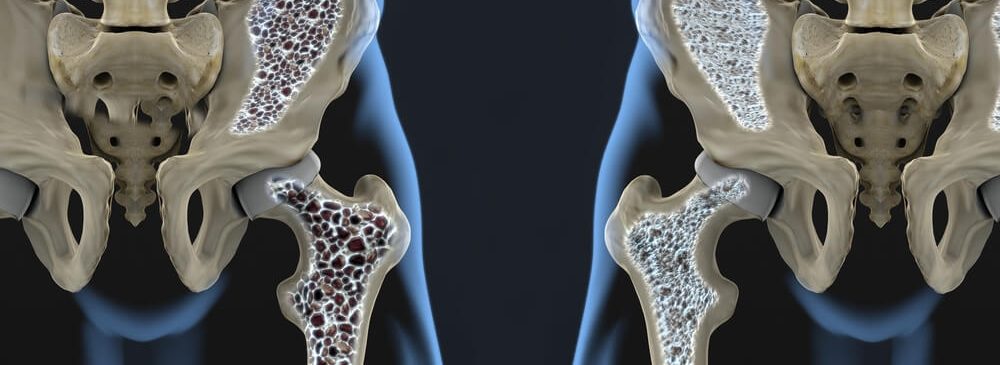Osteoporosis can be explained as a disorder affecting bones mass & density cause thinning. Osteoporosis makes bone delicate, fragile & more inclined to fractures.
How does Osteoporosis affect your bones?
Human bone structure is essentially formed of 2 type

Cortical bone: Also know as compact bone, forms a protective layer around the internal cavity and is the dense outer part of the bone. Almost 80% of the skeletal mass is made up of cortical bone.
Spongy bone: Also known as cancellous bone or trabecular bone, spongy bone is largely located inside the vertebrae .i.e. spinal column bony segment & within the ends of long bones like femur (thigh bone).
It provides structural support & flexibility.
A thigh bone is ordinarily made up of cortical bone accompanying the outside of the shaft of the bone & spongy bone present within the end of the bone, near a hip joint.

Osteoporosis affects bone health by making them porous. Structure & density of spongy bones is reduced, while cortical bone becomes less thick.
Osteoporosis shows no early sign or symptoms & usually diagnosed at a later stage where bone density is already lost affecting bones physical structure.
Osteoporosis and fractures
An individual suffering from osteoporosis observes thin and fragile bones owing to the loss in bone density mass.
In osteoporosis, fractures are more likely to occur in
1. The wrist
2. Vertebrate of spine
3. Thigh bone aka femur at the hip.
Quality of bones is degraded to a level where a fracture is caused by a minor fall or in severe situations due to insignificant bumps or sneeze.
Spine fracture can occur even due to simple movement like bending forward or lifting because of compression on weakened bone.
Such type of spine fractures leads to pain and curving of the spine linked with a reduction in height.
Tigh bone fractures at the hip because of fall may cause walking inability (until assisted) for a longer span of time. Long term nursing care is required also followed by a higher risk of death during the year after fracture.
With the advancement in technology treatment of osteoporosis .i.e. thickening of bone is possible. Even countermeasures to prevent the risk of developing osteoporosis are present.
Major risks of developing osteoporosis are
Age: People with older age approx more than 50 years face this problem. Around the age of 30 bone mass loss – the amount of bone formation is lower than the amount of bone absorption – is observed which gradually increases with increase in age.
Gender: Women are more prone to get osteoporosis as compared to men.
During menopause, a significant drop in the bone mass is observed because of a drop in the female hormone estrogen. So men don’t get osteoporosis? No, it a wrong assumption, men also become a victim of this disorder but very less frequently as compared to women. Bone density in men decreases slowly as compared to women. Low testosterone in men also increases the risk of developing osteoporosis. Mentioning about menopause, women may also benefit from knowing how long does it take for oral progesterone to work.
Hereditary: Some people suffer from osteoporosis because it runs in their family history. If your parents or grandparents are suffering from this disorder it’s likely that you may also suffer from the same.
Further risks are
- History of bone fractures after minor falls
- Marked spinal curve and loss of height with aging
- Being underweight as well as overweight increases the risk
- Deficiency of calcium & low vitamin D level
- Excessive alcohol consumption
- Smoking
- Medical conditions like thyroid, coeliac & rheumatoid.
- Medications like corticost
Prevention from osteoporosis
- Avoid excessive drinking & smoking
- Maintain your Vitamin D level – Expose yourself to the morning sunlight for vitamin d or take vitamin d supplements
- Consume a calcium-rich diet – Dairy foods, smoked salmon, green leafy vegetables, broccoli etc. Normally 1000 mg per day calcium is required in adults, whereas 1300 mg every day is required for older people.
- Follow a regular weight-bearing exercise routine like walking

